First Consensus Meeting on Menopause in the East Asian Region
Menopause - Country-specific information of the Republic of Korea
Hong-kyoon Lee
Department of Obstetrics and Gynaecology, Sangge Paik Hospital, College of Medicine, Inje University, Seoul, Korea
The proportion of elderly people in Korea has been increasing due to improved medical care service and decreased childbirth.
The Korean government has estimated the population of Korea at 45 million in 1996 [1]. The percentage of elderly people over 65 years was 3.4 in 1975, 5.8 in 1996, and will be 6.8 (3.2 million) in 2000 [1]. Moreover, people older than 50 years accounted for 11.7% of the population in 1975, 18.3% in 1996, and are expected to make up 20.1% in 2000 (Fig. 1) [2]. The female population between 45 and 54 years amounted to 2.1 million in 1990, 2.3 million in 1995, and is expected to be 2.6 million in 2000 and 3.4 million in 2005 [2]. The female population between 55 and 64 years old amounted to 1.5 million in 1990, 1.8 million in 1995, and is expected to be 1.9 million in 2000 and 2.1 million in 2005 [2]. The female population over 50 years was about 4.5 million in 1996. As the male death rate over 60 is higher than in females, the sex male/female ratio is getting unbalanced to 1.0/1.2 [2].
Fig. 1: Growth of population older than 50 and 65 years, respectively.
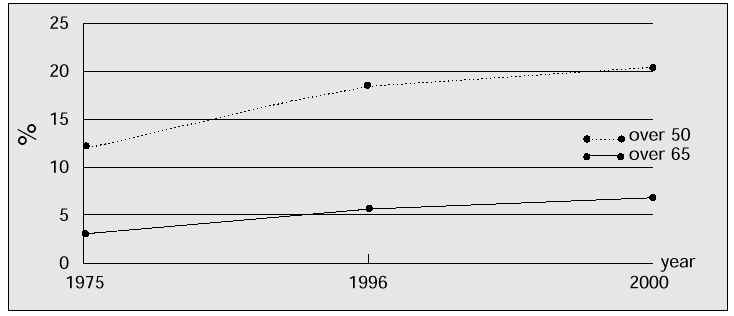
Since the traditional culture of the Korean society is male-dominated, like in other Asian countries, women usually did not have a job of their own, apart from working as a housewife. Since Korea has become a developed country, more women started working and pursuing a professional career, even after marriage. However, the population of working women (48.3%) was still low compared with men (76.4%) in 1995 (Fig. 2) [1]. According to the statistics of the International Labor Organization (ILO), in Korea in 1993, the percentages of middle-aged and elderly women who were employed were as follows: in women aged 40–44 years, 60.5%; from 45–49 years, 60.4%; from 50-54 years, 60.8%; over 55 years, 50.2% (Fig. 3) [1]. Because the ILO statistics include the agricultural population, the share of the elderly women’s working population can be estimated at < 20% if we exclude the women engaged in agriculture.
Fig. 2: Percentage of working population in 1995.
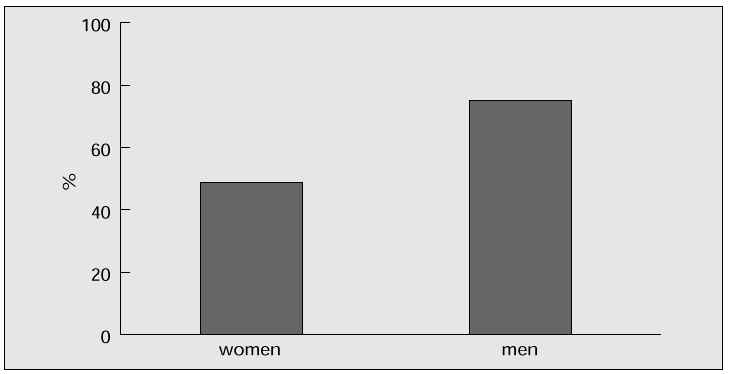
Fig. 3: Percentage of middle-aged and elderly women employed in 1995.
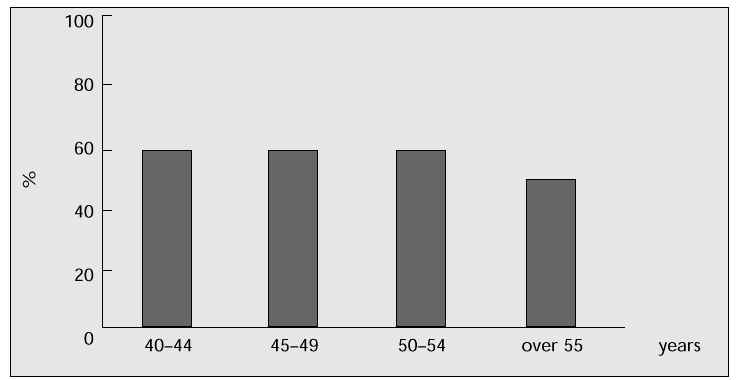
School education begins at the age of 6. The period of education is 6 years for elementary school, 3 years for middle school, 3 years for high school, and 4–6 years for university, respectively. Elementary school education in Korea is compulsory. In 1995, the number of women graduating from high school was 7.9 million (35.6%), while 2.1 million (9.4%) graduated from university [1].
The mean age of menarche is 13.2 years, which is 2.3 years earlier than 20 years ago. The women’s mean age of marriage is 22.4 years [2]. However, the percentage of unmarried women in their thirties and forties was 5.6% and 4.8% respectively, in 1995 [2]. In recent years, there is a tendency of delaying marriage probably due to higher education and the increasing number of women with a special qualification and profession.
The mean age at first delivery is 23.8 years, and that at the last delivery is 28.5 years. The mean number of children per family was 2.2 in 1994 [2]. However, the birth rate in 1994 was 1.75, which was almost the same as in other developed countries.
The natural menopause occurs at a mean age of 50.4 years [2]. The average life span has increased from 63.0 years in 1973, to 73.0 years in 1994. Average life span was 69.0 years in men and 78.3 years in women, as of 1995 [2].
About a half (53.0%) of malignant tumours in Korean women occur beyond the age of 60. In 1993, the most common malignant tumour was uterine cervical cancer (22.0%), followed by stomach cancer (17.9%) and breast cancer (11.4%) (Fig. 4) [3]. Among women over 60 years, degenerative arthritis, peptic ulcer/gastritis, hypertension and diabetes mellitus were the commonest diseases; in 1994 their prevalences were 19.5%, 15.5%, 10.8% and 6.7%, respectively (Fig. 5) [2].
Fig. 4: Common malignant tumours in women in 1993.
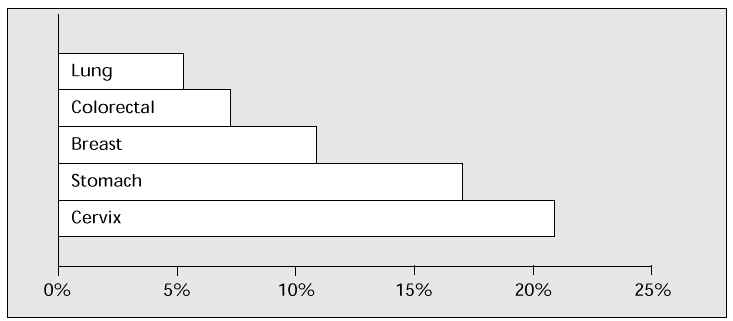
Fig. 5: Prevalence of common diseases in women over 60 years in 1994.
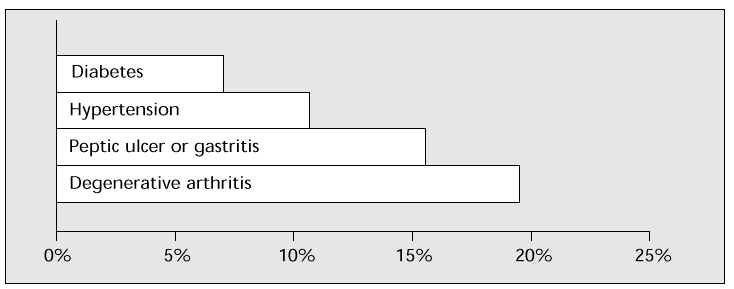
Unfortunately, the prevalence of osteoporosis in Korean women has not been defined accurately. However, about 15% of the patients registered at the Menopause Clinic of Seoul National University Hospital revealed radiologic evidence of osteoporosis by DEXA, and about 10% in Inje University Hospital. There were 17 menopause clinics in Korea in 1990, 47 in 1995, and there are expected to be 170 by 2000 and 240 by 2005 [2]. The number of bone densitometers was 26 in 1990, 500 in 1995, and there will be approx. 1400 in 2000 and 1600 in 2005. We do not have the results of the mass survey on menopause-related problems yet. However, we did perform a small survey in an urban area on menopause-related symptoms and hormone replacement therapy (HRT) [4]. Questionnaires were collected from 307 postmenopausal women living in the Seoul area in 1994. Among them, Colles, hip and spine fracture occurred in 68 women (22.1%), cerebrovascular accidents in 54 women (17.6%), and cardiovascular disease in 45 women (11.7%). More than three-quarters (75.9%) of the women had experienced various postmenopausal symptoms. 74% of them have not considered the menopause a serious medical condition, even though 40% of the women were aware of the effectiveness of HRT for the prevention of osteoporosis and cardiovascular disease. Information on HRT was obtained from friends by 43.7%, from TV/media by 32.3% and from their physician by 15.8% of the women, respectively. Among physicians who recommended HRT to the postmenopausal women, gynaecologists were the most important group (66.7%). 124 (40.3%) of these women had some experience with HRT, but only 17.5% took HRT for more than 1 year. The main cause of dropout was the fear of cancer (32.1%). After the establishment of the Korean Society of Menopause in 1992, nowadays most university and general hospitals in Korea are running menopause clinics. Most gynaecologists, internists, orthopaedics and family medicine practitioners have become acquainted with the problems of menopause and the benefits of HRT.
The common regimen of HRT prescriptions in Korea is the oral form of sequential combined estrogen and progestin. In these days, the number of clients using patches is increasing.
As previously described, the importance of carefully treating elderly women is obvious, not only because of the growing proportion of elderly women, but also for improving their quality of life.
References
1. National Statistical Office Republic of Korea. Korea Statistical Yearbook; 1996:43.
2. Ministry of Health and Welfare, Republic of Korea Yearbook of Health and Welfare Statistics; 1996:42.
3. Kim JP. Diagnosis, treatment and survival rate of 5 major cancers in Korea. J Korean Med Assoc 1995; 38:157–64.